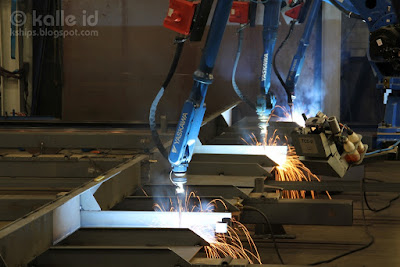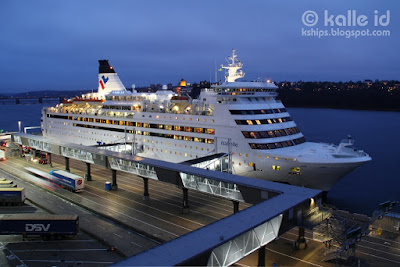As per the usual, all photos are mine – except, this time around, the artist's impressions from Hurtigruten, which are clearly marked. As usual, you can see the images in larger size by clicking on them.
 |
| The world's most environmentally friendly expedition vessel in the outfitting quay. |
Roald Amundsen
IMO 9813072
Built 2019, Kleven Ulsteinvik, Norway
Tonnage 20 889 GT
Length 140,00 m
Width 23,60 m
Draft 5,30 m
Ice class PC6
530 passengers
530 berths
4 Rolls-Royce Bergen diesels, combined 14 400 kW
2 Azipull azimuthing propellers
2 bow thrusters
Speed 15 knots
Fridtjof Nansen
IMO TBA
Built 2020, Kleven Ulsteinvik, Norway
Tonnage 20 889 GT
Length 140,00 m
Width 23,60 m
Draft 5,30 m
Ice class PC6
530 passengers
530 berths
4 Rolls-Royce Bergen diesels, combined 14 400 kW
2 Azipull azimuthing propellers
2 bow thrusters
Speed 15 knot
So, what was it like at Kleven? We had a chance to photograph the ships under construction (above and more below), were treated to several presentations from not only the people from Hurtigruten but also the Kleven shipyard and Rolls-Royce (who designed the ship), plus a lovely lunch of authentic food to be served onboard the ships. And, last but certainly not least, we had a chance to go onboard the Roald Amundsen in its incomplete guise, which is always an intensely interesting experience.
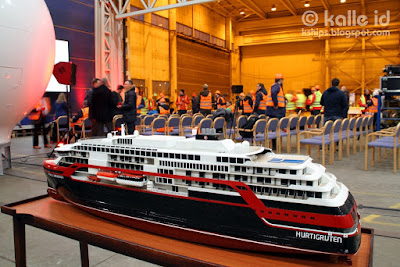 |
| Presentations (and lunch) were the yard's welding hall, which also had this nice model of the Roald Amundsen on display. |
 |
| Roald Amundsen under wraps in the lingering sunrise. |
 |
| The Fridtjof Nansen is still in a more incomplete state – but fortunately (for photos) not under wraps. |
 |
| Impressive ships up close, despite their modest dimensions. |
Next, it was time for our tour of the ship. Obviously, with delivery still half a year away, most of the Roald Amundsen's interiors are still far from finished – which, of course, made the visit all the more interesting!
 |
| The forward battery room. |
As you can see, the battery room is relatively empty. This, we were explained, is a concious strategy – as battery technology is currently developing at a high speed, Hurtigruten decided the sensible thing is to get additional batteries one technology has developed further, rather than get top-range batteries now and then discover in a few years they are outdated in terms of storage capacity. Considering how much resources the production of batteries takes up, this certainly lines up with Hurtigruten's sustainability efforts.
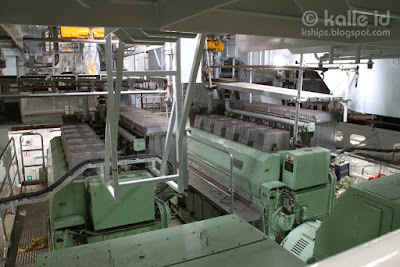 |
| The forward engine room, with two Rolls-Royce Vergen diesels. As demanded by regulations, there is a second, separate engine room with two additional main engines. |
 |
| The main dining room Aune, as it appeared yesterday... |
 |
| ...and as it will be in six month's time. Image courtesy of Hurtigruten. |
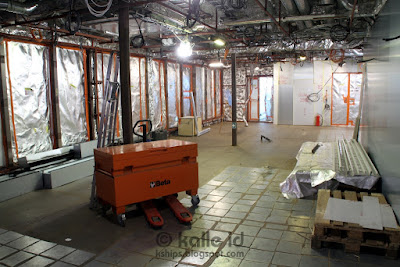 |
| Fredheim restaurent under construction... |
 |
| ...and as it will be. The windows especially look like they're going to be amazing (with all due respect to the decor, of course). Image courtesy of Hurtigruten. |
 |
| The science center did not look that impressive when we were there... |
 |
| ...but it not only looks to be impressive, it is also going to be innovative as heck. Image courtesy of Hurtigruten. |
 |
| Forward of the science center is an enclosed observation deck. |
 |
| Two cabins were already (almost) completely outfitted; here is a family cabin which should have a double bed, plus the convertible sofa you see in the foreground... |
 |
| ...and here is a standard balcony cabin for two. |
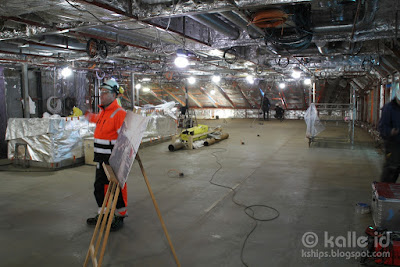 |
| On the traditional top-deck location there is an observation lounge... |
 |
| ...which will look much better when it's actually outfitted. Image courtesy of Hurtigruten. |
The Roald Amundsen is going to enter service in May 2019, and I really hope I will have a chance to go onboard again to see the ship as it is meant to be. But for now, special thanks to Hurtigruten for the chance to see the ships as they are now, and to Cruise Business Review for letting me be the one who goes to visit Kleven.
Edited 15.12.2018: Additional information for the ships' technical details.

